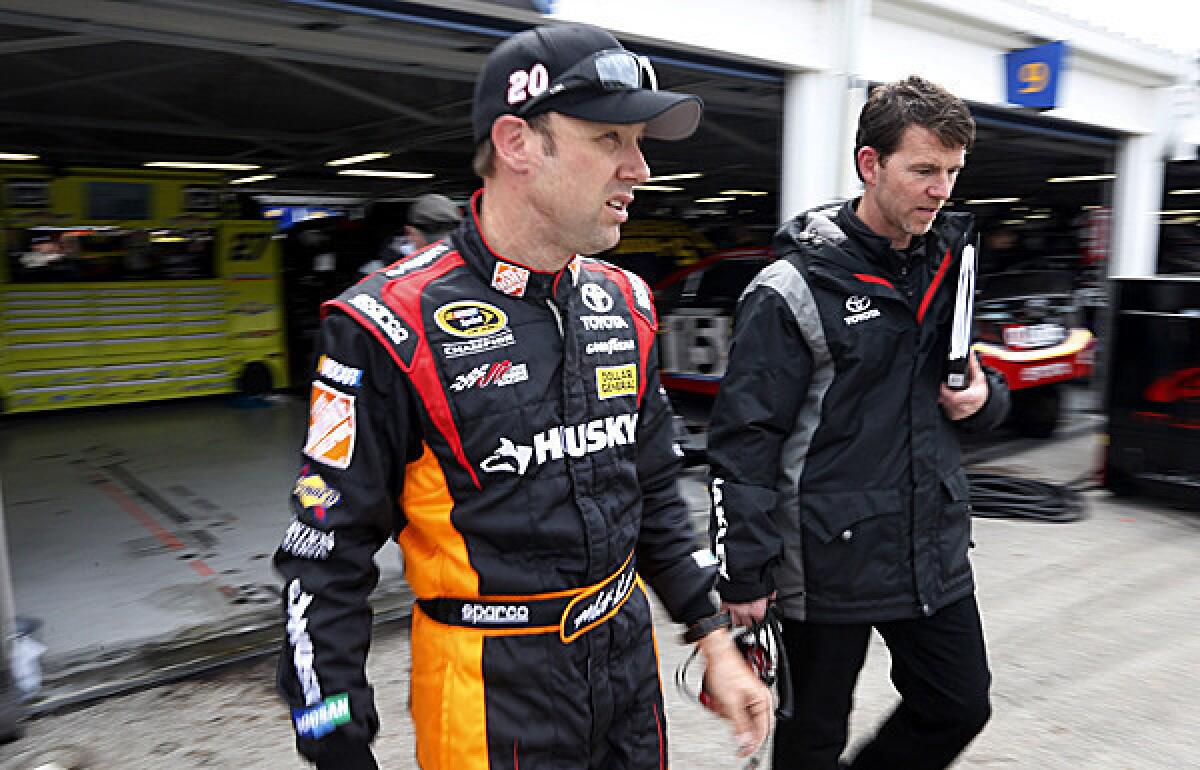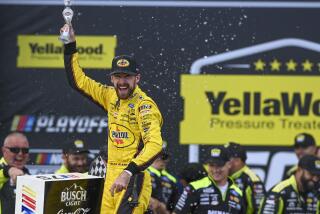NASCAR pounds Matt Kenseth with penalties

- Share via
Turns out an engine part on Matt Kenseth’s Toyota was three grams too light when the NASCAR driver raced to victory Sunday at Kansas Speedway, the equivalent of about two cotton balls in the words of his engine builder.
But in terms of Kenseth’s bid to win his second Sprint Cup championship, the violation carried the weight of an anvil.
Kenseth on Wednesday drew a massive 50-point penalty from NASCAR for having the unapproved part, knocking Kenseth from eighth in the Cup standings to a tie for 14th with Jeff Gordon.
Kenseth’s crew chief Jason Ratcliff was suspended for six races plus NASCAR’s All-Star Race on May 18, and Kenseth’s team owner, Hall of Fame NFL coach Joe Gibbs, also was penalized with the loss of car-owner championship points for those six races.
The culprit: a rod that connected one of the eight pistons to the crankshaft in the V-8 engine of Kenseth’s No. 20 Toyota that the automaker said was found to be 2.7 grams too light.
That sounds like a minor infraction, but it pointed up how NASCAR — which is using a new type of race car, dubbed the Gen-6, for the Cup series this year — has no patience when teams run afoul of its rules.
Indeed, the Kenseth/Gibbs penalties came only a week after two other leading NASCAR drivers, reigning Cup champion Brad Keselowski and Joey Logano, and their Penske Racing teams were heavily penalized for having unapproved suspensions on their Fords.
Penske is appealing, and Gibbs said it would appeal too.
Kenseth’s engine was built by Toyota Racing Development in Costa Mesa, which accepted the blame, saying the rod came from an outside vendor and was not checked before being shipped to Gibbs.
The rod was 2.7 grams — “about two balls of cotton” — below the required minimum, TRD President Lee White told SiriusXM NASCAR Radio.
TRD said in a statement that “It was a simple oversight on TRD’s part and there was no intent to deceive or to gain any type of competitive advantage.”
Pushing the limits of NASCAR’s rule book, or outright cheating, has long been a part of stock-car racing, as have NASCAR penalties aimed at curbing any violations.
And it would be wrong to say NASCAR lately has been especially punitive because it’s concerned about teams trying to get the upper hand with the new Gen-6 car, said Larry McReynolds, a longtime crew chief who’s now a NASCAR analyst on Fox and Speed TV.
“This penalty has absolutely nothing to do with the Gen-6 car” because having one rod 2.7 grams too light “is not even remotely an advantage,” McReynolds said. “It was a mistake.”
Even so, McReynolds said NASCAR always has particularly frowned on violations involving engines, and that NASCAR has to be consistent in enforcing its rules because it “can’t completely determine intent or non-intent.”
Kenseth, who joined Gibbs Racing this season, won from the pole at Kansas Speedway and led 163 of the race’s 267 laps.
Daytona crash update
Daytona International Speedway said it plans to reinforce the crossover gates along its grandstand fencing as a result of the multicar crash that injured at least 28 people Feb. 23.
Kyle Larson’s car got airborne and flew into the crossover gate portion of the fence, sending a wheel and other debris into the stands, at the end of a NASCAR Nationwide Series race.
The gates are opened before and after races for fans and officials to move between the stands and the infield.
Talladega Superspeedway in Alabama, another of NASCAR’s fastest tracks, already has reinforced its crossover gates, said Daytona President Joie Chitwood III.
NASCAR also has no plans to slow the cars at the two tracks, said Steve O’Donnell, NASCAR’s senior vice president for racing operations.
More to Read
Go beyond the scoreboard
Get the latest on L.A.'s teams in the daily Sports Report newsletter.
You may occasionally receive promotional content from the Los Angeles Times.










